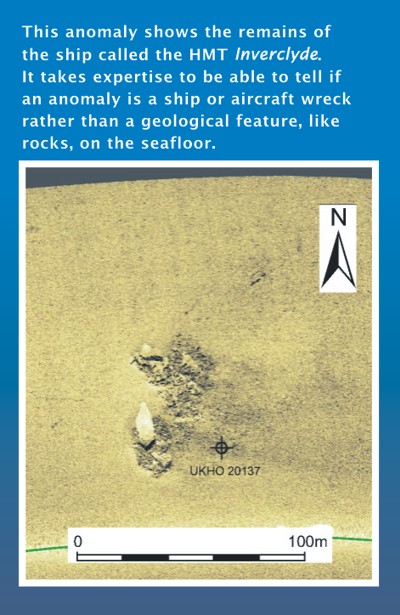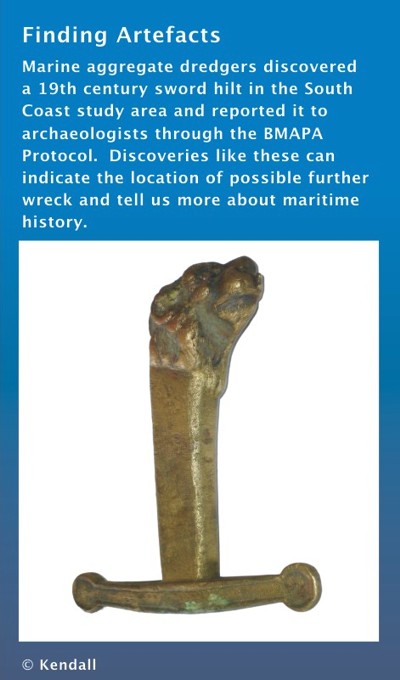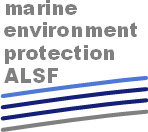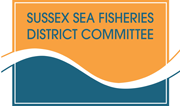 Archaeologists investigated the South Coast seafloor to find out what it can tell us about the past. They discovered evidence of ancient landscapes and shipwrecks lying deep below the waves.
Archaeologists investigated the South Coast seafloor to find out what it can tell us about the past. They discovered evidence of ancient landscapes and shipwrecks lying deep below the waves.
To collect information, archaeologists use a variety of geophysical and sediment sampling techniques that are also used by geologists and ecologists, including collecting sediment samples using a vibrocorer. Marine geophysicists who specialise in archaeology assess the geophysical survey data collected during the REC surveys.
The South Coast REC Archaeological Results
This section provides a summary of the South Coast REC results for the archaeological research.
Click on links below to find out about each topic, or scroll down to read the entire text.
- Did you know people once lived on the South Coast seafloor?
- Prehistoric climate change timechart
- Discovering Britain’s prehistoric past
- Finding ship and aircraft wrecks
- How important is a shipwreck?
- Aircraft wrecks
You can find out more about the scientific research techniques mentioned in the text by visiting our “How we study seafloor” webpages.
Read our Sustainability webpages to discover how the results will help protect the South Coast REC area.
Did you know that people once lived on the South Coast seafloor?
One of the key tasks for the REC archaeologists was to assess the potential for finding prehistoric evidence within the sediments beneath the seafloor. To do this they need to understand how the climate changed over the past million years.
Understanding past climate change
During the last 2.5 million years, known as the Pleistocene on the geological timescale, there have been numerous cold periods called ‘glacials’, separated by warmer periods called ‘interglacials’. Archaeologists are particularly interested in the last 1 million years when our ancestors are known to have occupied Britain.
During the cold phases large continental ice sheets covered much of Britain and most of the north-west European peninsula.
During warm periods the sea-levels were similar to those today and Britain was an island. However, during cooler periods, when water was locked up in ice sheets, the sea-level was lower than today. Britain was not an island but a peninsula, joined to continental Europe. During these cooler times our early ancestors were able to occupy large parts of the peninsula, now submerged beneath the sea.
At the end of the last glaciation, around 12, 000 years ago, the climate became warmer so people could live on the peninsula. Then, as the glaciers melted, the sea level rose and gradually flooded many places where people had lived. Geologists refer to the past 10,000 years as the Holocene.
Watch our film to see how the coastline of Britain changed over the past 20,000 years.
[jwplayer mediaid=”4061″]
This means that in the past people could live in the South Coast REC study area. However, what evidence do we have that they did?
Prehistoric climate change timechart
 Discovering Britain’s prehistoric past
Discovering Britain’s prehistoric past
Archaeologists use a variety of techniques to explore what evidence for the prehistoric past remains hidden on and below the South Coast seafloor.
Seafloor archaeological evidence mostly dates to the Palaeolithic and Mesolithic. These are terms for periods of prehistory. Check out our Prehistoric Climate Change timechart above to see how they fit into what happened during the Pleistocene and Holocene.
The geophysical survey data helps archaeologists to build a picture of how the landscape looked in the past, before the sea’s currents and movement of seafloor sediments modified it.
Marine geophysicists examined the geophysical survey data for features, such as river channels cut and then filled with seafloor sediments during the Pleistocene and Holocene. Preserved within such deposits you can find environmental remains, such as seeds and animal shells.
Archaeologists take samples of these deposits from underneath the seafloor using a vibrocorer. Peat is sometimes found. It is formed from plant material that once grew when this study area was dry land; its presence tells us that an area was once marshy – a good place for people to find food and other resources.
The environmental evidence from cores can give us a picture of the landscape at that time. In the South Coast study area, examination of environmental remains showed that during the Mesolithic birch and pine woodland surrounded the edges of marshy areas.
River channels, like the palaeo-Solent channel, are also important for archaeologists to identify evidence of our ancestors. As people need water to live, river features are useful places to start looking for archaeological evidence for Britain’s prehistoric past.
 Finding ship and aircraft wrecks
Finding ship and aircraft wrecks
Geophysical survey allows archaeologists to discover amazing things that survive on the South Coast seafloor, including ship and aircraft wrecks.
It is impossible for divers to examine every part of the seafloor for wrecks. Not only is it expensive and very time-consuming, the dark British waters make it difficult to see.
To assess the potential for wrecks in the South Coast study area, the archaeologists examined the geophysical survey images, which mapped what the seafloor looks like.
Archaeologists identified 250 anomalies that could possibly be ship or aircraft wrecks.
As the geophysical survey only covered part of the whole study area, there are probably many more undiscovered wrecks on the seafloor.
The archaeologists could not find historic records for most of these anomalies so some may be completely new discoveries. Others may turn out not be archaeological.
Geophysics has been excellent for identifying shipwrecks that date from the 19th century onwards, but not so good for detecting earlier ships. This is because later ships are substantial and made from metal, which shows up well on geophysical survey.
On some occasions, geophysical surveys do discover older shipwrecks. For example, the Swash Channel wreck was discovered following a geophysical survey in 2004 in the South Coast study area. The identity of the ship is still unknown but examination of the remains of the ship suggest it dates to the mid 17th century.
Also, historical documents recording shipwrecks show that there are many shipwrecks pre-dating the 19th century in the South Coast study area.

Swash Channel wreck: a 17th century wooden ship wreck found through geophysical survey© Crown copyright produced by Wessex Archaeology
 How important is a shipwreck?
How important is a shipwreck?
One of the tasks for the South Coast archaeologists was to assess the importance of individual known shipwrecks.
There are several criteria for assessing the historical importance of a shipwreck. It depends what its potential is for telling us about the past; some ships are so important that they are protected by law.
A shipwreck can be a time capsule, recording everything that was happening on the ship when it sank.
The 18th and 19th centuries were a time of innovation in shipbuilding; technological change was rapid. In some cases, a type of ship was only around for a short time before the invention of a better version. Many ships were taken apart to build new ships. Sometimes shipwrecks are the only examples left of their type and can tell us a lot about how shipbuilding changed.
In other cases, it is the stories that are attached to the ship and the part it played in history that makes it important.
During the war many ships sank. Some shipwrecks are the final resting places of those who fought or worked on these ships. These are protected places, as they are war graves.
The South Coast archaeologists assessed those shipwrecks whose identity or types were known to help us understand their importance. This will inform future measures to protect them as a record of our maritime heritage.
Find out about the important SS Mendi shipwreck in our Sustainability webpages.
Aircraft Wrecks
Aircraft wrecks also survive under the sea. Most of these date to World War II, when aeroplanes played an important role in the defence of Britain from attack.













